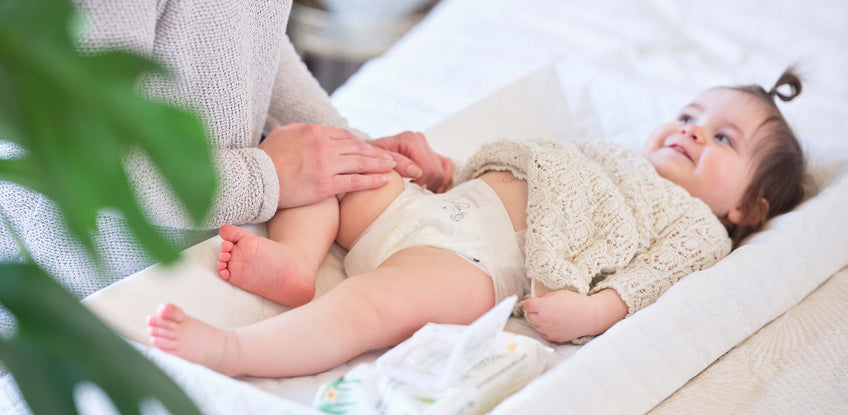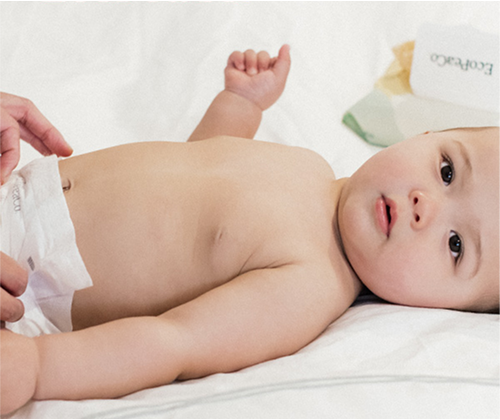Diaper rash: the bane of many a parent’s existence. This nasty skin condition consists of red, inflamed skin on baby’s bottom and genitals, and can lead to an inconsolable child, and stressed-out parents. Because it’s such a common phenomenon, the baby-products market is saturated with “miracle cures.”
However, these products are not all created equal, as some expose baby to potentially harmful chemicals. To skip the risk, consider these all-natural, and super effective, remedies for diaper rash.
11 Natural Ways to Soothe Diaper Rash
When diaper rash symptoms start showing up, you can apply any of the following after gently cleansing, and patting their bottom dry. Let your natural remedy of choice soak in before putting on a new diaper.
Breastmilk
If you're a breastfeeding mama, you likely already know the amazing healing benefits of breastmilk (clogged tear ducts, baby acne, cuts etc), but did you know that dabbing breastmilk on diaper rash can soothe the affected area too? Breastmilk is filled with healing and antiseptic properties, and is a natural moisturizer while also being anti-inflammatory. It's also a great, on-the-go option when you are looking to treat diaper rash naturally.
Coconut Oil
This multi-purpose oil naturally has anti-fungal and antimicrobial properties that can kill the Candida that causes many diaper rashes. It also reduces inflammation and increases hydration while also acting as a barrier between baby's rash and their diaper. It's basically a one stop shop.
A little goes a long way, and if baby is not at risk for a coconut allergy, coconut oil can be a safe and effective natural remedy to use to prevent diaper rash as well.
Apple Cider Vinegar
Diaper rashes caused by either fungal or yeast infection, can be treated naturally with apple cider vinegar. The fermented liquid kills bacteria that agitates the rash, and prevents the growth of yeast.
Mix one part ACV with three parts water before use and either dab it on to the diaper rash with your fingers or a light cloth. Apple Cider Vinegar can be very drying, so we recommend using sparingly and only using on fungal rashes. Follow up with a healthy swipe of coconut oil to maintain moisture.
Olive Oil
Provide itch relief by treating the rash naturally with olive oil, which has anti-inflammatory and antimicrobial properties. Olive oil is also extremely nourishing and moisturizing so can help alleviate any pain or discomfort associated with the rash as well. A little goes a long way here as well.
Honey and Chamomile Spray
Create a mega-soothing, all-natural antiseptic spray by dissolving one teaspoon of raw honey into two cups chamomile tea, and transferring the mixture to a small spray bottle to spray directly onto baby's bottom (be sure to let it cool completely first!).
This is a great mixture to keep on the change table and allows for some extra play-time while you let it dry.
Oatmeal Baths
Oatmeal is super soothing for skin and can easily be added to your baby's bath to nourish their diaper rash naturally.
Baking Soda Baths
Baking soda is alkalizing and a great natural diaper rash treatment. Add a scoop to their bath to help alleviate pain and bring down redness from any rash.
Be sure to rinse the area thoroughly, pat dry and apply a moisturizing cream or some coconut oil to maintain moisture.
Plain Yogurt
Full of probiotics and good bacteria, yogurt helps to reestablish the skin's own healing mechanisms. It's cool and yummy texture helps to soothe the area and provide your baby relief.
Be sure to throughly cleanse and dry the area before putting another diaper back. We recommend plain, unsweetened yogurt for this as any added sugars could irritate the rash further.
Cornstarch
Cornstarch is a pantry staple that works much the same as baby powder, by keeping the affected area dry and creating a barrier for the rash to heal faster. This is especially helpful on warm days where moisture may collect more frequently in your baby's bum or in those perfect little thigh rolls.
Aloe Vera
Aloe vera has anti-inflammatory properties and is super soothing, which is why we recommend this natural treatment, and why we include a small amount in our bamboo diapers and wipes too!
You'll want to choose a pure form of aloe, like directly from the plant or aloe vera juice (not gel) to ensure it is unprocessed and that you are getting the full benefits.

Air Time + Sunshine
Sometimes, simply giving our skin some space and good old fresh air allows it to do it's job and heal itself without the need for expensive creams or added products. That's why we love to suggest lots of diaper free time not only to treat diaper rash naturally, but to prevent diaper rash naturally as well.

Preventing Diaper Rash Naturally
While it’s great to have natural treatments when a diaper rash develops, it’s even better to prevent it. First, it’s important to understand what causes diaper rashes. Typical culprits include irritants in a diaper or skin cream, a bacterial or yeast infection, chafing, a new food that causes changes in fecal matter, and the use of antibiotics.
The following strategies can help you bypass rash-triggers and save your baby’s tush from this uncomfortable condition.
Switch diaper brands
Some diapers contain volatile organic compounds that could cause skin irritation. You can easily take care of the problem by switching to a diaper brand that’s hypoallergenic, and contains no harmful chemicals, like chlorine, phthalates, dioxin, alcohol, latex, or fragrances. Bamboo diapers and wipes are great, sustainable options.
Purchase larger diapers
If you notice your baby’s diapers becoming snug, go to the next size up, as chafing from a too-tight diaper can create skin irritation. In addition, don’t put the diaper on too tight – aim for it being just tight enough to contain a mess.
The two finger test (can you fit two fingers comfortably in the waistband when the diaper is secure?) is a great benchmark to ensure it's not on too tight.
Use natural fibre wipes
Just like diapers, some wipes contain ingredients that can provoke a rash. Minimize this risk by using wipes that are hypoallergenic, free of irritating chemicals and fragrances, and contain aloe, like Eco Pea's bamboo wipes.
Let baby go without a diaper
Because moist areas create breeding grounds for the bacteria and yeast that can cause a diaper rash, it’s best to let baby go without a diaper for a bit, if you notice the beginnings of a rash. During this time, go outside with baby if the weather is nice, or have them play on a waterproof mat that’s covered with a soft material.
Change diapers more frequently
You can reduce the aforementioned presence of bacteria- and yeast-producing moisture, by regularly changing baby’s diaper. The longer they sit in a wet diaper, the higher their chance of developing a diaper rash. In addition, be sure to thoroughly clean their crevices, as left over urine or poop particles could prompt a rash as well.
Keep a food diary
To pinpoint foods that cause a rash, keep a log of any new foods you feed baby. For example, if you gave them a new food on Monday and Tuesday, and they developed a rash on Wednesday, your food journal could help you deduce that this new food might be the cause.
Foods most likely to provoke a diaper rash include citrus fruits, strawberries, tomatoes, plums, and dairy.
If your baby is solely breastfed, keep track of changes in your diet, as certain foods that pass through the milk could create a rash.

Natural Remedies for Diaper Rash
While diaper rashes are usually inevitable in your baby’s first year, these natural remedies and preventions can help you bypass frequent, long-lasting skin irritations.
Although we hope that a diaper rash can be prevented or alleviated via natural methods, consult a paediatrician or dermatologist if it persists or is severe.
As a bonus, the treatments mentioned are often household staples, meaning you won’t have to spend extra money on over-the-counter creams that may or may not work. Here’s to a rash-free, happy baby!


